Konstruktion#2
for three for three metal pieces, one string, voices and live-electronics
The composition exists in two versions:
Konstruktion#2: Tro (2017)
Konstruktion#2: Karkk (2016)
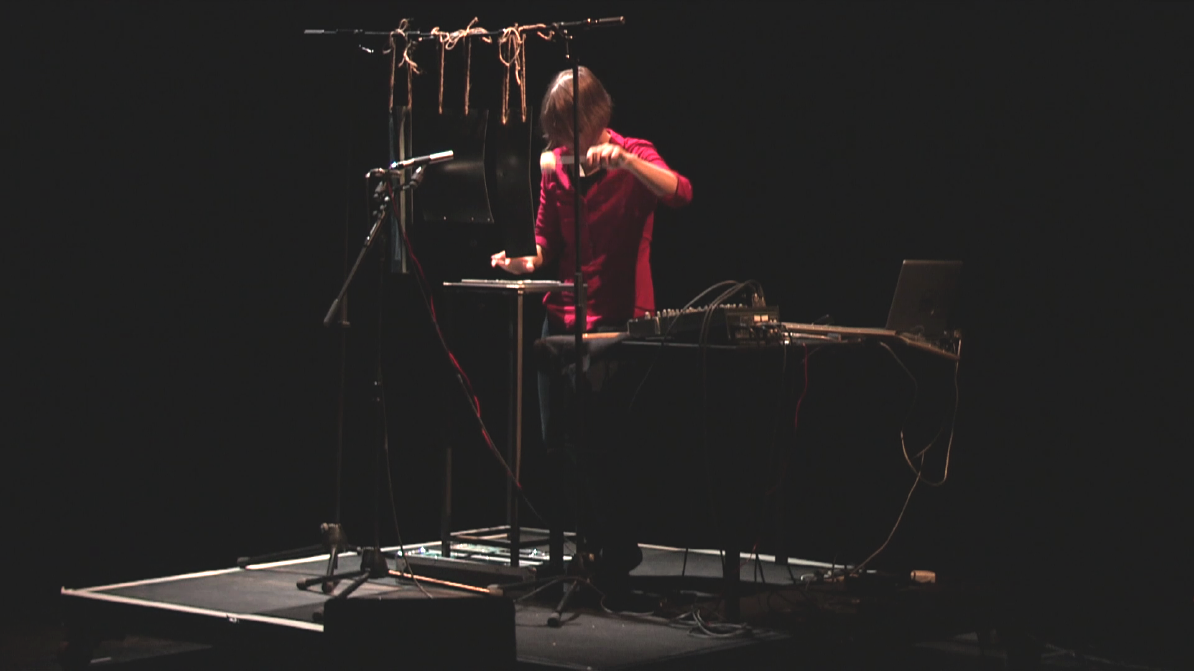
Konstruktion#2 is a sound sculpture/ a new sound- setup and composition, developed for the realization of the electro-acoustic solo pieces Konstruktion#2: Tro (2017) and Konstruktion#2: Karkk (2016) .
It is inspired and shaped by the sounds and overtone spectra of three metal pieces.
Its topic is the exploration and presentation of new proportions and sounds via exploring inherent legalities and possibilities of the highly amplified metal, the exploration of the melting of reality and surreality, of sounds and their shades.
The setup consists in the three hanged metal sheets, one electric guitar, two microphones, one tablet, one mixing desk, one Arduino and a computer/MaxMSP. Via TouchOSC, a tablet and a wire sensor, the MaxMSP- software can be controlled in real time.
The compositions Tro and Karkk are in such a way structured, that they can be performed in recognizable ways, which are however never identical. Thus every concert becomes unique and shows different perspectives on the fundamental idea of the composition.
Tro and Karkk, two versions of the same composition, differ from each other concerning their compositional technique just slightly in two passages (part 1b and 2b, see below).


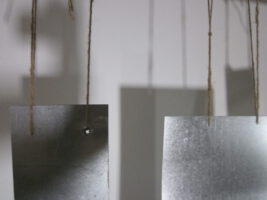
Details and process
Part 1a – metal piece 1

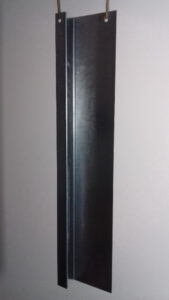
Metal sheet 1 is bowed. Its sound is amplified and transmitted via a microphone touching directly the metal. During the bowing process, a “molecule of sound”, a spectral excerpt, gets extracted through touching a sensor, which is fixed at the microphone.
This excerpt will be digitally processed.
For extracting the sound, I use a freeze- subpatch, published in the tutorial “A Tutorial on Spectral Sound Processing Using Max/MSP and Jitter” by Jean-François Charles/ Computer Music Journal 2008. This tutorial is as open source free available:
http://www.mitpressjournals.org/doi/abs/10.1162/comj.2008.32.3.87
https://cycling74.com/toolbox/charles-spectral-tutorials/
Because it is not possible to control which exact snapshot, which “slice of time” of the sound is extracted, the structure of its digital transformation, of its digital shadow, sounds in each concert different:
Metal 1,
First transformation: studio
Metal 1,
first transformation: concert A
Metal 1,
first transformation: concert B
Part 1b – Variation over metal piece 1
Part 1b is a song-like section (whereby the term “song” is freely defined). It is built on reconstructed tonal particles of the first bowed sound. Frequencies of metal piece 1, reconstructed via sinus waves, are blending with interjections of a speaker. The underlying recording of these interjections was made in a private context: it is a recording of a text, the speaker wrote and presented himself. His text contains many mirrorings.
Version Tro (2017):
Tonal particles of the first bowed sound, “frozen” through the freeze sub-patch, are analyzed and reconstructed by sine waves in real time. The sine waves reproduce the metal’s tone particles of the exact moment, they are triggered by assigned faders. They stay on a fixed pitch, or can connect two different captured sound-moments through glissandi in various speeds. The begin and volume of the sine waves is controlled manually. Their end is determined via randomized automatations.
Version Karkk (2016):
Characteristic frequencies of metal piece 1 were analyzed, reconstructed via sine waves and are taped.
Bowed original sound:
Characteristic frequencies of the sound between 663,38 and 861,77Hz:
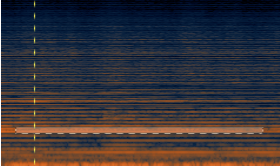
Free replica of this frequency range with sine waves:
Further characteristic frequencies:
903Hz
1015Hz
Part 2a – metal piece 2
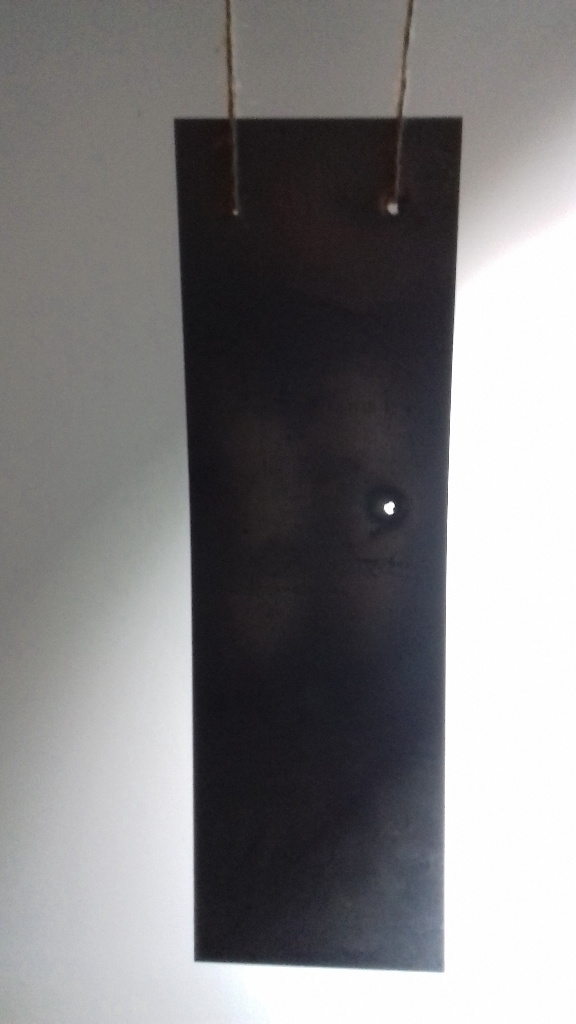
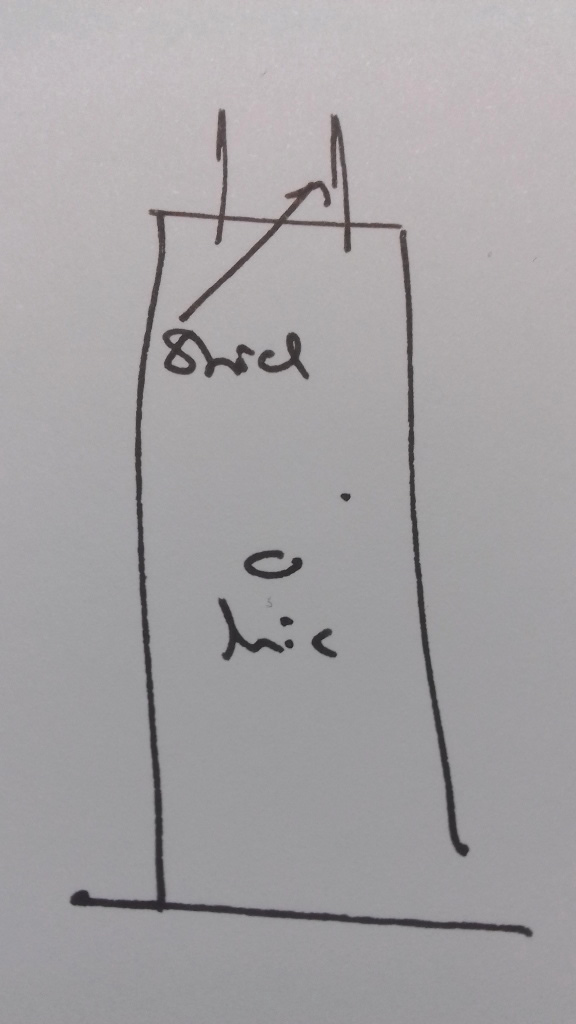
Metal sheet 2 is bowed. Its sound is amplified and transmitted via a microphone contacting directly the metal.
(…) (see above, part 1a).
Part 2b – Variation over metal piece 2
Also part 2b has a “song-like” structure, combining reconstructed tonal particles of the second bowed sound with vocal interjections. The speaker of the underlying voice recording is a 7-year old girl. She recites with enthusiasm the ABC-poem, which she learned in school. Also this recording was made in a private context.
Version Tro (2017):
Like in part 1, sinus waves, representing a momentary snapshot of tonal particles of the assigned sound (the frozen sound of metal piece 2), are activated by faders. Unlike in part 1b these tones will be not bent, but faded out after being actively triggered within a randomly calculated time frame in different velocities.
A pure tone of 378Hz, situated a semitone under the fundamental frequency of metal piece 2 (~397,8Hz), is transmitted through the whole section. The G-String of the guitar, activated via an Ebow and as well tuned in 378Hz, is bended parallel to this tone slowly upwards.This glissando passes over the section the fundamental frequency of metal piece 2, and ends in the course of this part until the interval of a octaved minor second over this frequency.
Version Karkk (2016):
Frequencies, located in the upper frequency spectrum of the original sound (more determinant frequencies in the lower spectrum are partially rebuilt and played in part 3) are analyzed and reconstructed via pure tones as tape.
Bowed original sound, metal piece 2: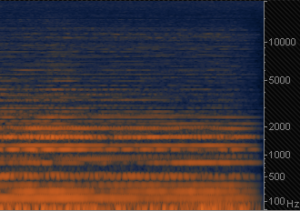
Spectral excerpt 1: 1272-1326 Hz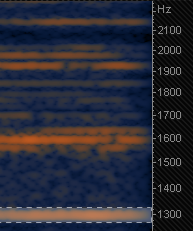
Spectral excerpt 2: area around 1598 Hz
Sine tone located one second below the ground tone of the frequency range, octavated:
378Hz:
Guitar tone:
The G-string tuned in 378Hz is bent slowly with the tremolo arm upwards. The glissando passes the ground tone of the frequency range, and can end in the course of this section until the interval of a small octaved third over 378Hz, thus until a octaved second over the ground tone of the selected frequency range.
Part 3 – three metal pieces
All three metal pieces are amplified and played percussively with a wood piece, a soft mallet and two metal pieces. Their signals are routed to the loudspeakers both in pure form and digitally transformed. Additionally, single pitch-transposed metal sounds, and via pure tones reconstructed frequencies of the metal pieces are added to the overall sound.
Version Karkk: reconstructed frequencies of metal piece 2 are played as prepared tape.
Version Tro: the frequencies of the actual played metal pieces are analyzed and reconstructed in real time and added to the mix on the basis of pre-composed rules.
Some percussive metal sounds are digitally “frozen” directly after the touch (see above, part 1a) and added to the overall sound in the form of curved shadows. The microphones are adjusted in such a high intensity, that with the aid of a gen pitch controller and a ring modulator,the sum of all signals throws “streaks”, colored shadows, which interact and change each other like paints, melting into one another.


